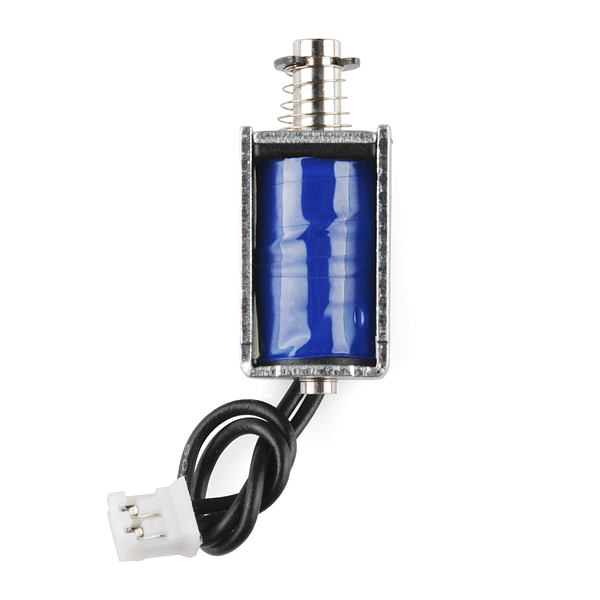In the world of actuators, it seems that motors get most of the attention. They’re cool, they’re sexy, they run circles around things (often literally).
I’m a simple man with simple needs. I just need this thing to open. And then close. And then open. And then close. You know what’s perfect for that? Solenoids.

What does a solenoid do? Take your index finger and push it straight into a button. Keep holding the button until you decide to release the pressure and stop pushing the button. Congratulations, you just solenoided that button.
Literally, all a solenoid does is push or pull a metal rod straight out a short distance when voltage is applied. Simple, yes, but used in so, so many applications, from locks to valves to relays. Combined with mechanical advantages a solenoid with a “throw” (distance between in and out position) of just a couple inches can open and close doors. A common affect on stage is to use a solenoid to break glass on cue.
This particular solenoid is a China Special, Zonhen ZHO-0420L/S, found on Sparkfun for $4.95. It requires 5 volts of power, has a throw of about 4.5mm, and can push with up to 320 grams of force. Datasheet here.
One thing about solenoids is that when turned off (voltage removed) they can generate a substantial voltage that is sent back on the circuitry. Without proper protection, this voltage will fry your electronics, particularly your microprocessor. For this reason you need to put a diode in place that will absorb this “backlash” of power.
There are various tutorials available for using solenoids and arduinos, a quick a dirty one I liked is https://www.inkling.com/read/arduino-cookbook-michael-margolis-2nd/chapter-8/recipe-8-6




Here is a very unusual application of two solenoids: http://www.instructables.com/id/RFID-cat-door/. In OFF state, they are blocking the door from unauthorized animals. sick:)
That’s so cool! If I ever leave the city and get a cat again, I can definitely see myself creating something like this. And I can think of scenarios where it’d be useful to feeding different cats (e.g. two roommates who each have a cat, and the cats need to be fed different foods).
I think what you found was really amazing, it seems that Solenoids to a degree have such a simple purpose and design. From the research I have done, it seems that some of their other capabilities is to create controlled magnetic fields. They can also serve as an electromagnet, which can be used in MRI machines, relays, generators and hard disks.
I like their practicality and how many of the objects in our everyday lives already have a Solenoid in them. It is intriguing how these devices are used, but how will you use them for your final project? I ask cause it seems like you’re going to make something simple in design yet practical for others to use and it seems as though a Solenoid may play a key role in your final project.
http://www.instructables.com/id/Controlling-solenoids-with-arduino/?ALLSTEPS
I found these cool videos that shows you how to control Solenoids with an Arduino to power engines and use it to push a simple object.
To be honest, I’m probably not going to use these in my final project – I’m probably doing an LED heavy project. But in the world of actuators, I find solenoids much more interesting. They really are everywhere, often hidden and you’d never guess they were there if you didn’t know.